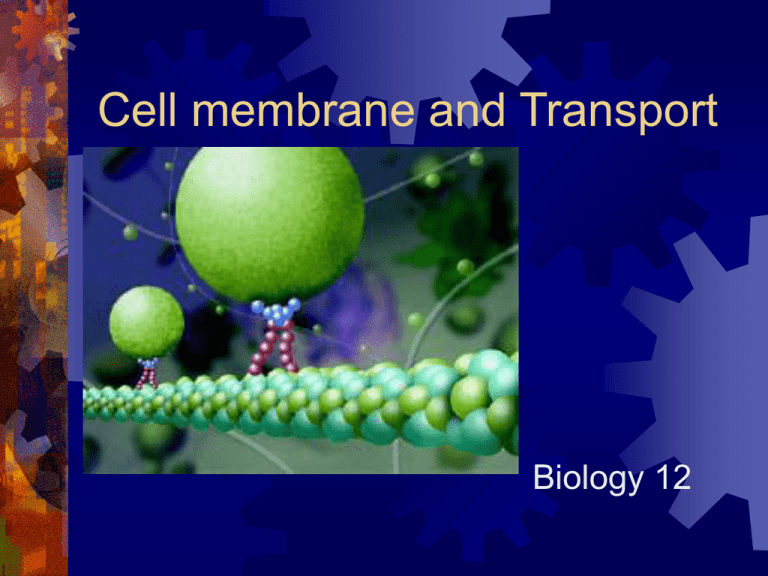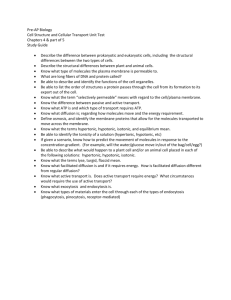Cell membrane and Transport
advertisement

Cell membrane and Transport Biology 12 1. Carrier molecules that bring materials into the cells are… A. lipids B. proteins C. glycogen D. phospholipids 2. The fluid-mosaic membrane model describes the membrane as having a… A. sheet of protein B. phospholipid bilayer C. sugar-phosphate backbone D. complementary base template 3. Molecules in the cell membrane that function as receptors are… A. proteins B. glycerol C. cholesterol D. phospholipids 4. Cell membranes are composed mainly of… A. sugars and phosphates B. phospholipids and proteins C. carbohydrates and cellulose D. nucleotides and carbohydrates 5. Which of these substances cannot pass through cell membranes? A. Starch B. Glycerol C. Amino acids D. Monosaccharides 6. Which of the following conditions is required for diffusion to occur? A. ATP energy B. A living cell C. A concentration difference D. A selectivelypermeable membrane 7. The rate of diffusion across the cell membrane is affected by the A. temperature and pinocytosis B. temperature and the size of the molecule C. membrane structure and phagocytosis D. shape of glycolipids and glycoproteins 8. Frog eggs placed in an isotonic solution will… A. burst B. shrink C. remain the same D. increase in volume 9. When put in a hypotonic environment, an animal cell will… A. swell B. shrink C. secrete enzymes D. remain unchanged 10. Which of the following conditions would cause red blood cells to burst? A. pH of 7.5 B. temperature of 30°C C. being placed in distilled water D. being placed in an 11% salt solution 11. The cytoplasmic concentration of solute in a cell is 0.05%. This cell is placed in a solution that causes the cell to swell and burst. The solute concentration of this solution is A. 0.005% B. 0.05% C. 0.5% D. 5.0% 12. In an experiment, frog’s eggs were placed in a salt solution. After several hours their mass increased significantly. We can therefore conclude that, compared to the frog’s eggs, the solution was… A. isotonic B. saturated C. hypotonic D. hypertonic 13. A cell would tend to gain water if it were moved from… A. an isotonic solution to a hypotonic solution B. an isotonic solution to a hypertonic solution C. a hypotonic solution to an isotonic solution D. a hypotonic solution to a hypertonic solution 14. If the solute concentration of solution A is greater than solution B, then solution A is said to be A. isotonic to solution B B. osmotic to solution B C. hypotonic to solution B D. hypertonic to solution B 15. Which of the following moves material against a concentration gradient? A. osmosis B. diffusion C. active transport D. facilitated transport 16. Which of the following processes moves molecules using cellular energy? A. osmosis B. diffusion C. pinocytosis D. facilitated transport 17. Which of the following processes would be directly affected by a lack of cellular ATP? A. osmosis B. diffusion C. active transport D. facilitated transport 18. Pinocytosis is accomplished by the cell using the A. nucleus B. cell wall C. cytoplasm D. cell membrane 19. The process taking when a cell engulfs larger protein molecules and internalizes them in vesicles is… A. osmosis B. exocytosis C. phagocytosis D. facilitated transport 20. How many of the following factors would affect the permeability of the cell membrane? •Size of molecules •Lipid solubility of molecules •Presence of transport channels •Presence of ATP inside the cell. A. one B. two C. three D. four 21. Which of the following aids the movement of glucose across a cell membrane? A. protein B. phosphate C. glycolipid D. cholesterol 22. A shortage of available ATP would hinder a cell’s ability to import A. water B. protein C. oxygen D. carbon dioxide 23. Which of the following will be affected directly if the mitochondria in a cell are not functioning properly? A. absorption of alcohol by the cell B. the movement of water into and out of the cell C. the movement of oxygen across the cell membrane D. the movement of sugar from a low to a high concentration 24. A slice of potato placed in distilled water becomes firm after several hours because… A. salt has passed into the potato cells B. cellulose synthesis in the cell wall has been stimulated C. water has passed into the potato cells causing the cells to swell D. water has passed out of the potato cells causing the cells to shrink 25. Glycogen is not normally found in the blood because… A. free glucose molecules are stored as starch B. free glucose molecules are converted to amino acids C. glycogen can be structurally incorporated directly into the cell wall D. glycogen molecules are unable to diffuse through the cell membrane 26. The cell process which uses ATP to bring substances into the cell is… A. osmosis B. diffusion C. active transport D. facilitated transport 1 2 The End 3 4






